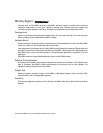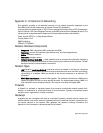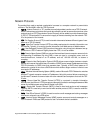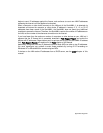Page 266 SonicWALL Internet Security Appliance Administrator’s Guide
Subnet Mask
The IP addressing system allows subnetworks or “interchanges” to be created and device numbers
or “extensions” to be established within these subnetworks. These numbers are created using a
mathematical device called a subnet mask. A subnet mask, like the IP address, is a set of four
numbers in dotted decimal notation. Subnet masks typically take three forms:
• 255.0.0.0
• 255.255.0.0
• 255.255.255.0
The number 255 “masks” out the corresponding number of the IP address, resulting in IP address
numbers that are valid for the network. For example, an IP address of 123.45.67.89 and a subnet
mask of 255.255.255.0 results in a sub network number of 123.45.67.0 and a device number of
89. The IP address numbers that are actually valid to use are those assigned by InterNIC. Otherwise,
anyone could set up IP addresses that are duplicates of those at another company.
The subnet mask used for the network typically corresponds to the class of IP address assigned. If
the IP address is Class A, it uses a subnet mask of 255.0.0.0. Class B addresses use a subnet mask
of 255.255.0.0, and Class C IP addresses use a subnet mask of 255.255.255.0.
Default Gateway
A default gateway is like a long distance operator. Users can dial the operator to get assistance
connecting to the end party. In complex networks with many subnetworks, gateways keep traffic
from traveling between different subnetworks unless addressed to travel there. While this helps to
keep overall network traffic more manageable, it also introduces another level of complexity.
To communicate with a device on another network, one must go through a gateway that connects
the two networks. Therefore, users must know the default gateway IP address. If there is no gateway
in the network, use an IP address of 0.0.0.0 in fields that apply to a default gateway.
Network Address Translation (NAT)
NAT hides internal IP addresses by converting all internal host IP addresses to the IP address of the
firewall as packets are routed through the firewall. The firewall then retransmits the data payload of
the internal host from its own address using a translation table to keep track of which sockets on
the exterior interface equate to which sockets on the interior interface. To the Internet, all of the
traffic on the network appears to come from the same computer.
Nodes
A node is a device, such as a PC or a printer, on a network with an IP address. The feature chart
shows how many node licenses for PCs or printers are included with a SonicWALL Internet Security
appliance. The TELE3 has a non-upgradeable 5-node license, but the SOHO3 is upgradeable up to
have 10, 50, or an unlimited number of node licenses. The PRO 100, PRO 200, and PRO 300 have
an unlimited number of node licenses.
The TELE3, SOHO3-10, and SOHO3-50 allow a maximum of 5, 10, or 50 LAN IP addresses,
respectively, to exist on the LAN (Local Area Network). The licenses for the nodes are counted
cumulatively, not simultaneously. When the SonicWALL is turned on and configured, the SonicWALL


















